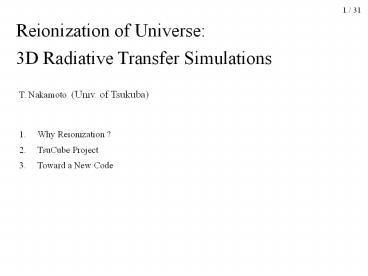Reionization of Universe: PowerPoint PPT Presentation
Title: Reionization of Universe:
1
Reionization of Universe 3D Radiative Transfer
Simulations
T. Nakamoto (Univ. of Tsukuba)
- Why Reionization ?
- TsuCube Project
- Toward a New Code
2
1. Why Reionization ?
- Radiation Feedback
- ---- Effects for Following
Generation - - Photoionization
- - Photodissociation
- - Photo Heating
- Observation
- ---- Probe for First
Generation - - Emissions
- - Absorptions
1. Why Reionization ?
3
3D Reionization Calculations
Photon Conservation Method ( Tree Method)
Abel et al. 1999, Abel Wandelt 2001, Razoumov
et al. 2002 Direct Incident Radiation
Ciardi et al. 2001, Susa Umemura Local
Optical Depth Approx. Gnedin
2000 Optically Thin Variable Eddington Tensor
Formalism Gnedin Abel 2001 Full 3D
Radiative Transfer Nakamoto, Umemura,
Susa 2001
w/ HD Stellar source
w/o HD QSO source
4
Adaptive Ray Tracing
(Abel Wandelt 2002)
5
Razoumov et al. 2002
6
Monte Carlo
Ciardi et al. 2001
HD RT (post processing)
7
3D RHD Cosmic Reionization
(Gnedin 2000)
z 9
XHI
Cosmological HD 1010-12 Msun RT (Local Optical
Depth Approx.) Star Formation H, He H2 form/dest
T
ngas
8
Optically Thin Variable Eddington Tensor
(Gnedin Abel 2001)
XHI
LOD
OTVET
9
N31283 in (8Mpc) 3, Nangle 1282
An Example Evolution of Ionization State
Zeldovich approximation z 15
Radiative Transfer
Ionization Equilibrium
Nakamoto, Umemura, Susa 2001
1. Why Reionization ?
10
Reionization History of an Inhomogeneous Universe
I210.1
Z15
Z9
Z7
Z5
1. Why Reionization ?
11
Shadowing Effect
Inhomogeneous
Homogeneous
12
3D Reionization Calculations
Photon Conservation Method ( Tree Method)
Abel et al. 1999, Abel Wandelt 2001, Razoumov
et al. 2002 Direct Incident Radiation
Ciardi et al. 2001, Susa Umemura Local
Optical Depth Approx. Gnedin
2000 Optically Thin Variable Eddington Tensor
Formalism Gnedin Abel 2001 Full 3D
Radiative Transfer Nakamoto, Umemura,
Susa 2001
w/ HD Stellar source
w/o HD QSO source
13
2. TsuCube Project
Comparisons of 3D RT codes
Common Test Problem(s)
- Groups/Codes
- CRASH (Ferrara, Ciardi, Maselli)
- CORAL (Iliev)
- OVTET (Gnedin, Abel)
- Cen
- Razoumov
- Tsukuba (Nakamoto, Umemura, Hiroi)
14
Test Problem 1
Input
no dynamics
Output
- I-front propagation (Time Dependence)
- UV intensity _at_ each grid point
- computation speed
15
Tsukuba's Current Code Short Characteristics
Method
max 1283 x 1282
Radiation Energy Density
Distance
Not good for a point source (Better for diffuse
radiation)
16
3. Toward a New Code
Improvement of Our Code ART (Accurate RT)
- Time Dependence
- Accuracy
- (Speed)
17
Time Dependece
Current Status 1D OK 2D now struggling
3D next step
18
Accuracy Speed
Short Characteristics Method
(KunaszAuer 1988)
Ray Group of Segments
Good - of Operation Small - Simple Bad -
Numerical Diffusion
Cost
?
Suitable for large simulation, though its
accuracy is limited.
19
Numerical Diffusion
Long Char.
Short Char.
20
ART (Accurate/Accelerated Ray Tracing) Method
Radiation - On a radiation mesh Quantities on
Hydro Mesh - Interpolated from values on the
radiation mesh.
Good - of Operation Small - Small Numerical
Diff. Bad - Complicated
?
Cost
This has good points of both the Long Char. the
Short Char.
21
ART
Quite small numerical diffusion
Accuracy of ART Long Char.
22
Computational Time
Measured Time (WS)
Theoretical Predicted timing (2D-Plane case)
Long Char.
3
N
ART
If Space N2 Angle 1 Frequency 1
Time sec
Short Char.
2
N
Long Char. N3 Short Char. N2 ART N2
Space Grid Size N
23
SC (2D 322 x 1024)
Energy Density
r
24
SC (2D 322 x 1024)
25
2D NN mesh
Y
N
Nangle
O
X
N
26
ART (2D 322 x 1024)
Energy Density
r
27
Source (emitting toward One quadrant) Vacuum Grids
Space 32x32, Angle 256 ( 64 x 4)
32 x 256
28
ART (2D 322 x 1024)
29
ART (2D 322 x 64)
30
SC (2D 322 x 64)
31
4. Summary
Reionization Simulations TsuCube Project
Comparison of 3D RT Codes Developement of a
New Code 3D Time Dependece Accuracy Speed

